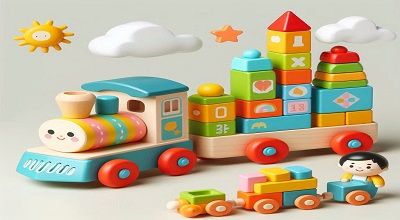Educational Toys for 1-2 Years Old
Choosing educational toys for 1-2-year-olds can be a fun and rewarding process. At this age, children are exploring their surroundings and developing basic motor skills, language, and cognitive abilities. Here are some educational toy ideas that can stimulate their development:
Stacking and Nesting Toys:
- Benefits: Develop hand-eye coordination, fine motor skills, and spatial awareness.
- Examples: Stacking cups, and nesting blocks.
Soft Building Blocks:
- Benefits: Enhances creativity, and motor skills, and introduces basic math concepts.
- Examples: Soft foam or fabric blocks.
Shape Sorters:
- Benefits: Introduces basic shapes and improves fine motor skills.
- Examples: Toys with different-shaped holes and corresponding blocks.
Sensory Balls:
- Benefits: Enhances tactile stimulation and sensory exploration.
- Examples: Textured rubber or fabric balls.
Musical Instruments:
- Benefits: Introduces children to different sounds and rhythms, fostering an early interest in music.
- Examples: Shakers, small drums, xylophones.
Picture Books:
- Benefits: Encourages language development and visual recognition.
- Examples: Board books with simple pictures and textures.
Puzzles with Large Pieces:
- Benefits: Develop problem-solving skills and hand-eye coordination.
- Examples: Large-piece puzzles with simple pictures.
Ride-On Toys:
- Benefits: Enhances gross motor skills and coordination.
- Examples: Ride-on cars, and push toys.
Sorting and Stacking Toys:
- Benefits: Teaches basic concepts like colors, shapes, and sizes.
- Examples: Toys with multiple pieces that can be sorted or stacked.
Interactive Toys with Buttons:
- Benefits: Introduces cause-and-effect relationships and fine motor skills.
- Examples: Toys with buttons that produce sounds or lights.
Soft Plush Toys:
- Benefits: Provide comfort and can be used for imaginative play.
- Examples: Soft animals, dolls.
Simple Puzzles:
- Benefits: Boosts problem-solving skills and hand-eye coordination.
- Examples: Puzzles with knobs for easy gripping.
Summary
Remember to choose toys that are free from small parts that could be a choking hazard, and always supervise playtime. Additionally, playing with your child and engaging in interactive activities will enhance the educational value of these toys.
